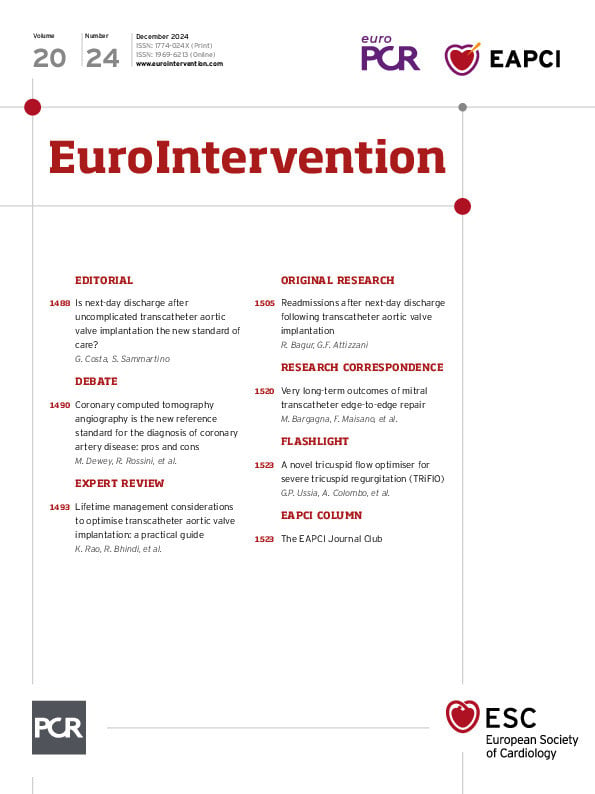Cory:
Unlock Your AI Assistant Now!
The minimisation and simplification of transcatheter aortic valve implantation (TAVI) procedures have set the basis for the development of ad hoc, streamlined periprocedural pathways to improve patient management and to increase the sustainability of TAVI programmes over the past decade.
The North American Vancouver Multidisciplinary, Multimodality, but Minimalist Approach to Transfemoral Transcatheter Aortic Valve Replacement (3MTAVR) and the European Feasibility and Safety of Early Discharge after Transfemoral TAVI (FAST-TAVI) trials were the first to prospectively assess the feasibility of early discharge after transfemoral TAVI by applying specific clinical criteria12. Both studies considered patients receiving the balloon-expandable SAPIEN transcatheter heart valve (THV) platform (Edwards Lifesciences), which has been historically associated with lower rates of permanent pacemaker implantation (PPI) after the procedure compared to the self-expanding CoreValve/Evolut THV platform (Medtronic), and up to 80% of patients in the Vancouver 3MTAVR trial were discharged the day after the procedure.
More recently, the Project to Look for Early Discharge in Patients Undergoing TAVI With ACURATE (POLESTAR) trial assessed the feasibility of early discharge in TAVI patients receiving the self-expanding ACURATE neo THV platform (Boston Scientific), and the Optimize PRO Study demonstrated that next day discharge (NDD) after TAVI was also feasible in selected patients receiving the Evolut PRO/PRO+ THVs following a specific implantation protocol to minimise the risk of conduction disturbances34.
In addition, different groups demonstrated that NDD was also feasible in unselected TAVI patients treated in everyday clinical practice in whom the procedure was uneventful567.
Shortening the length of stay (LoS) following transfemoral TAVI is essential to minimise the risk of hospital-acquired complications and healthcare resource utilisation but could carry potential drawbacks, especially the risk of rehospitalisation for delayed, procedure-related complications.
In this issue of EuroIntervention, Bagur et al specifically investigate the issue of hospital readmission after NDD following transfemoral TAVI using the three most-used newer-generation THV platforms (ACURATE neo/neo2, Evolut PRO/PRO+/FX, SAPIEN 3/Ultra) in unselected pacemaker-naïve patients8.
The authors reported that NDD was feasible and safe across the three different THVs with no significant differences in 30-day all-cause readmissions (8.0%). Notably, cardiac readmissions accounted for less than half of these events (3.7%), mostly related to heart failure and conduction disturbances requiring PPI (41.7% and 47.2%, respectively). These data were in line with the rehospitalisation rates reported in the Vancouver 3MTAVR and FAST-TAVI trials, and no differences were reported among the three devices.
Moreover, the rates of 30-day readmission were lower in NDD patients compared to those discharged thereafter.
These results corroborate the applicability of an NDD strategy for uncomplicated TAVI procedures in common clinical practice, but it should be acknowledged that, in the study, patients were treated in high-expertise, high-volume centres, where ad hoc periprocedural TAVI pathways were part of the standard of care.
Optimised procedural and periprocedural protocols can be effectively adopted regardless of the type of THV used, and the possibility to tailor the THV selection according to patient characteristics may further increase the possibility to avoid procedure-related complications and to safely discharge patients the day after the procedure.
Assisted, early mobilisation after the procedure allows a rapid recovery and facilitates next-day discharge in those patients free from adverse events. In view of this, the presence of a dedicated, trained nurse team for patient care during the early hours after TAVI is essential to tailor the postprocedural pathway to individual patient needs.
Indeed, even in uneventful procedures, close monitoring is necessary to detect subclinical, transient atrioventricular conduction disturbances or loss of haemoglobin that could result in delayed, complete atrioventricular blocks or major vascular complications after the discharge, respectively, therefore affecting the safety of NDD after TAVI. Moreover, in a small percentage of TAVI patients, especially those with concomitant cardiac damage, the restoration of haemodynamic compensation could necessitate the reassessment of diuretics and antihypertensive drugs intake, and this should be guided by postprocedural echocardiographic findings. Prolongation of the LoS by 24-48 hours after day 1 should be considered in this subset of patients to ensure the safety of early discharge after TAVI.
Tailoring TAVI therapy and pathways to individual patient characteristics should be a fundamental of current TAVI programmes, which must incorporate ad hoc periprocedural protocols and dedicated professionals.
It is possible that implementing a patient home-monitoring programme after the discharge may also further reduce readmission rates for those patients who can effectively be managed with remotely guided changes in pharmacological therapy.
Importantly, the optimisation of TAVI pathways needs to be properly recognised by reimbursement-based healthcare systems. Indeed, some nation-specific regulations still limit the possibility to minimise hospitalisation length and to optimise the allocation of hospital resources.
In conclusion, the demonstration of comparable readmission rates in NDD patients and patients discharged later reported by Bagur and colleagues should reassure physicians about the safety of NDD after uncomplicated TAVI procedures in unselected patients.
Early mobilisation and discharge on the day after minimalistic transfemoral TAVI should be considered the standard of care after uneventful procedures in current clinical practice, but patient-tailored postprocedural pathways must be implemented in all centres to preserve the safety of this strategy.
Conflict of interest statement
The authors have no conflicts of interest to declare.

